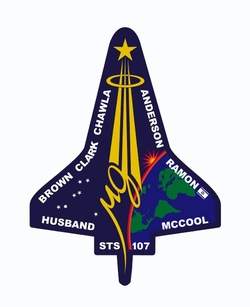STS-107 MCC Status Report #08; Wednesday, January 22, 2003 -- 6
p.m. CDT
 The seven astronauts aboard Columbia beamed down
television views of their smallest companions in orbit today,
including insects, spiders, fish, bees and silkworms that are part
of the Space Technology and Research Students package of
experiments designed and developed by students in six
countries.
The seven astronauts aboard Columbia beamed down
television views of their smallest companions in orbit today,
including insects, spiders, fish, bees and silkworms that are part
of the Space Technology and Research Students package of
experiments designed and developed by students in six
countries.
The television pictures showed ants busily creating and moving
about tunnels in an ant farm developed by students from Fowler High
School in Syracuse (NY); Garden Orb Weaver spiders beginning to
construct webs in an enclosure designed by students at Glen Waverly
Secondary College of Melbourne, Australia; silkworm larvae,
beginning to develop in an experiment designed by students at
Jingshan School, Beijing, China; Medaka fish embryos' developing in
a tank designed by students at the Tokyo Institute of Technology in
Tokyo; and carpenter bees' beginning to construct nests by boring
tunnels in wood.
The experiments are being monitored by both teams of astronauts
as they work in shifts to support the 80 different experiments
aboard the space shuttle and the Spacehab Research Double Module.
The Red Team -- Commander Rick Husband, Mission Specialists Kalpana
Chawla and Laurel Clark and Israel Space Agency Payload Specialist
Ilan Ramon – enjoyed a half-day off before resuming work with
a variety of other experiments.
 The Red Team worked with the growth of prostate
cancer cells in the Bioreactor Demonstration System, shutdown of
the Laminar Soot Processes experiment, which completed 14 runs in
an effort to better understand the nature of soot created by
combustion in microgravity, and bacteria and yeast growth as part
of the Microbial Physiology Flight Experiment. They also checked on
the growth of plants in the Astroculture experiment that includes
miniature roses being grown in space to produce new fragrances for
perfumes.
The Red Team worked with the growth of prostate
cancer cells in the Bioreactor Demonstration System, shutdown of
the Laminar Soot Processes experiment, which completed 14 runs in
an effort to better understand the nature of soot created by
combustion in microgravity, and bacteria and yeast growth as part
of the Microbial Physiology Flight Experiment. They also checked on
the growth of plants in the Astroculture experiment that includes
miniature roses being grown in space to produce new fragrances for
perfumes.
The Red Team handed over to the Blue Team – Pilot Willie
McCool, Payload Commander Michael Anderson and Mission Specialist
Dave Brown – at 5 p.m. CST, and prepared for a sleep shift
beginning at 7:09 p.m. The Blue Team awoke at 3:09 p.m. to the song
“Hakuna Matata” by the Baja Men for Anderson from his
two kids.
The Blue Team began its day with work on the SOFBALL, or
Structures of Flame Balls at Low Lewis-number experiment, which
scientists hope will improve their understanding of lean (low fuel)
burning combustion and lead to improvements in engine efficiency,
reduced emissions, and fire safety.
 The overnight team also worked with the Advanced
Respiratory Monitoring System, a European Space Agency experiment
looking at how the human body adapts to weightlessness.
The overnight team also worked with the Advanced
Respiratory Monitoring System, a European Space Agency experiment
looking at how the human body adapts to weightlessness.
After lunch, the team was to calibrate the Mediterranean Israeli
Dust Experiment (MEIDEX) and resume observations after adjusting
the shuttle orientation in orbit to facilitate measurement of small
particles in the atmosphere over the Mediterranean Sea and Atlantic
Ocean off the coast of the Sahara desert.
Cooling and humidity control of the Spacehab module is being
effectively managed through minor adjustments to systems aboard
Columbia and the science module.
 NTSB Prelim: Lee Aviation LLC JA30 SuperStol
NTSB Prelim: Lee Aviation LLC JA30 SuperStol Classic Aero-TV: Curtiss Jenny Build Wows AirVenture Crowds
Classic Aero-TV: Curtiss Jenny Build Wows AirVenture Crowds ANN's Daily Aero-Term (05.30.25): Very High Frequency (VHF)
ANN's Daily Aero-Term (05.30.25): Very High Frequency (VHF) Aero-News: Quote of the Day (05.30.25)
Aero-News: Quote of the Day (05.30.25) ANN's Daily Aero-Term (05.31.25): Microburst
ANN's Daily Aero-Term (05.31.25): Microburst





